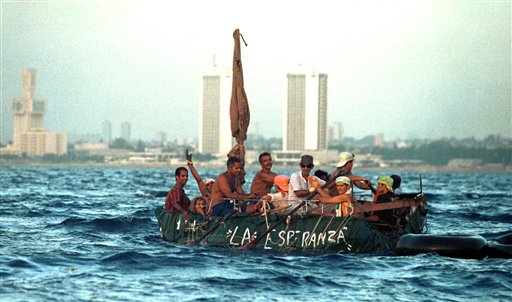Cubans keep jumping into the sea to try to reach the United States | Photo taken from Latin American Studies Group
It’s like playing Russian Roulette. Although the numbers are terrifying– one in three rafters is a snack for the sharks — many people in Cuba take the issue with a lightness that causes chills.
Probably the Straits of Florida is the largest marine cemetery in the world. There are no hard figures of the children, young people, adults, and elderly who lie under its turbulent waters.
It’s a human drama with obvious political overtones. The regime wants to tell the story their way. People leave the island, they say, encouraged by the Cuban Adjustment Act that awards automatic residence to Cubans who step on United States soil.
It’s true. The frivolity of the U.S. wet foot/dry foot policy, seems like a macabre game. If the gringo coast guard catches you at sea, you’re returned to Cuba. If you manage to touch land, you won the lottery.
Although absurd, the share of moral responsibility remains with the olive green autocracy. Only the despair, the lack of a future, and the economic burden could drive a person to plan this dangerous journey across the sea.
People leave Cuba because things are going badly. Those who don’t have relatives in the United States, or who put off the family reunification paperwork, risk their future on a raft.
Let me tell you a story of rafters that happened in my neighborhood. Since Christmas 2013 Gregorio (name changes) was persuading relatives and friends disposed to change their fate with a marine adventure.
After 1994 when the Fidel Castro regime decriminalized illegal departures to the North, the future rafters plan their projects without too much discretion.
Gregorio was obsessed with the idea of leaving the country. Part of his family lives in Miami. He spent years doing the legal paperwork: “I don’t want to get to Florida when I’m 60.”
Finding allies for such an undertaking is not hard in Cuba. Young people without a future swarm every corner of the island. A priority: people with nautical knowledge.
Guys with experience who failed in other attempts. People with money to build the safest craft possible. Human traffic from Cuba to the United States is a buoyant industry.
But not everyone can afford the $10,000 for a ticket. There are different kinds of immigrants. There are those who choose to cross land borders, jumping from one nation to another in long and dangerous journeys from Ecuador, or paying cash to a Mexican coyote to put them across the border.
Then there are the rafters. According to José,”We are the most desperate. I have friends who have tried dozens of times. If they’re caught by the Cuban or U.S. coast guard, they always intend to try again. Many have become old salts.”
Gregorio had never tried. After recruiting twelve partners (everyone brought something, one sold a Moskovich car, another, two HP computers), they contacts an expert in designing marine craft.
The job isn’t cheap. A powerful and reliable engine is no less than four or five thousand dollars on the black market. They got three GPS for a possible localization, among other goods.
Friends were being added to the adventure. In April 2014 they were 22 people. Gregorio alerted family and friends who have yachts in Miami, so at any given moment, if they washed up on a key, they could be towed to the shore.
The GPA is essential. The artisanal craft designer had to be top of the line. They chose an ex-mechanic of a merchant boat who boasted he knew remote river passages in the Florida keys.
Before departing, at 2:30 in the morning on Wednesday, April 23, they said goodbye to their loved ones with a couple quarts of cheap whiskey.
They were carrying food and water for two weeks in case of shipwreck. A chessboard, Spanish cards and a game of dominoes. As if instead of a risky sea journey they were going on a peaceful safari.
Family in Havana tracked them through an illegal antenna on the cable news updates on Miami TV. Apparently, on Friday at lunchtime good news arrived.
The mother of one of the rafters called his family to say that Channel 23 had aired a story about the supposed boat with a child traveling. The rumor spread like wildfire. The Miami family of the rafters called Krome and other immigration detention centers in Florida. They could not confirm the event. They toured hospitals and coast guard offices. Nobody knew anything of the rafters. They began to panic.
The family members in Cuba called the rafters cellphones insistently. For now, the only signal is a laconic request from a recorded voice saying, “The number you are calling is turned off or outside the coverage area.”
Neighbors and friends try to encourage the rafters’ relatives. “An uncle was twelve days at sea until landfall in Key West.” Or, “You have to wait, they’ve only been at sea for 6 days.” Family members on both sides of of the Strait sleep poorly, eat little and suffer from nerves. They pray to their saints and pray for the lives of their own. Each day that passes without news is synonymous with bad omens. And the death of a rafter, usually, no one can confirm it.
Photo: One of the many rickety boats that came from the Havana coast towards the coast of Florida during the so-called “Rafter Crisis” in August 1994. In these twenty years, despite an increase in the chances of emigrating by legal means , Cubans continue to jump into the sea to try to reach the United States. Taken from Latin American Studies Group.
Iván García
6 May 2014

